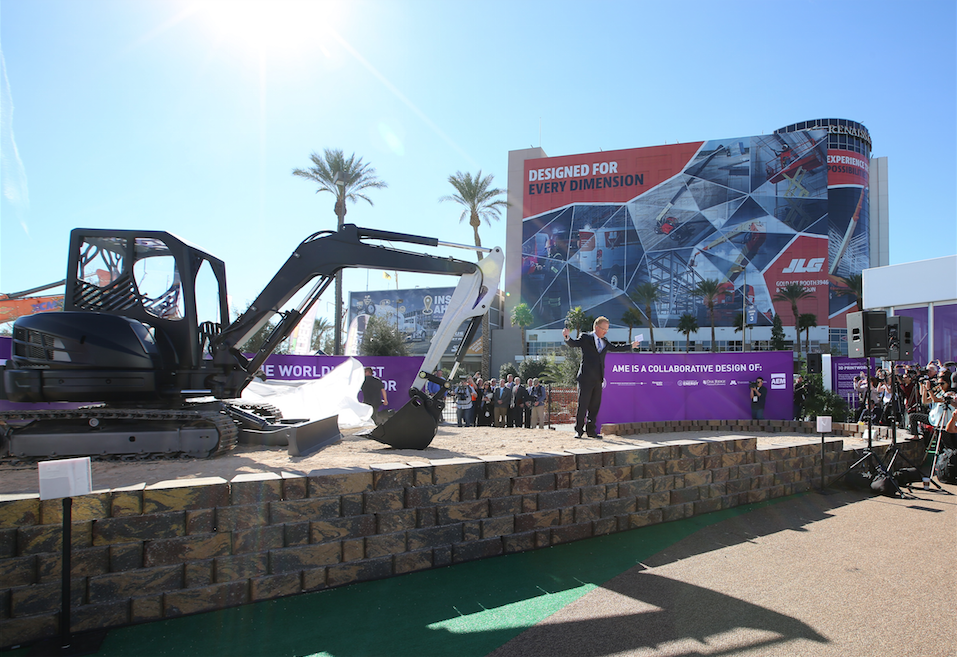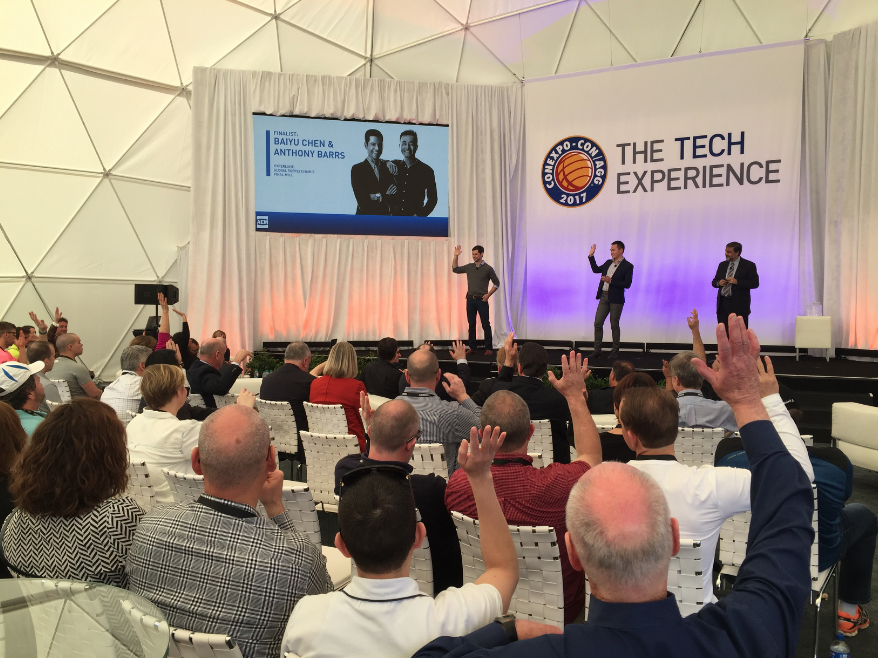ConExpo Tech Experience Pavilion Shows Future Engines, Machines
BY AsphaltPro Staff

As you’ve seen throughout this New Products edition of AsphaltPro, original equipment manufacturers (OEMs) are looking into the future with the iron and technology recently introduced. At CONEXPO-CON/AGG and IFPE 2017, a Tech Experience pavilion anchored the largest show floor in history. Tech challenges issued before the show culminated on site and experts offered long-range visions for us to contemplate.
For example, the Association of Equipment Manufacturers (AEM) helped to convene the Infrastructure Vision 2050 Challenge Finale event. The winner was a proposal from a pair of University of California-Berkeley students to leverage autonomous vehicle technology to develop a surge-priced “Hyperlane” to ease congestion and improve mobility.
And don’t forget the Tech Experience pavilion housed the first 3D-printed excavator.
“Keeping pace with technology is critical for our industries’ success and the 3D printed excavator featuring fluid power innovations, is a perfect example of the shows’ future-forward commitment to explore innovations that are happening now and the exciting possibilities ahead,” Robert Mortensen, IFPE 2017 Chair said.
The New Tech Experience amplified the technology throughout the show floor, with an emphasis on emerging construction innovations that are driving change across the industry. Three interactive zones gave attendees a glimpse at the technologies shaping the jobsites of tomorrow, infrastructure development and workforce development. The “Tech Talks” forum gave attendees a chance to hear from global innovators to discuss what lies ahead. But other areas of the show had forward-looking information that can directly impact the contractor’s bottom line.
During the “What’s Now” Speaker Series that took place on the CASE Construction Equipment stage in the North Hall, Dave Piech, who is the vice president for engine compliance NAFTA, CNH Industrial, shared emissions regulatory news relative to the Trump transition, and what he anticipates for future emissions standards regarding Tier 5. He spoke specifically of the two major drivers in creating newer, more stringent regulations: the U.S. Environmental Protection Agency (USEPA) and the California Air Resources Board (CARB).
As readers may know, there are changes coming up at the end of this year with the Transitional Program for Equipment Manufacturers (TPEM) or “Flex,” for our non-road equipment engines. This program allows the continued use of Tier 3 and Interim Tier 4 engines for now. The use of Tier 3 engines that are 130 to 560 kW size starts to change at the end of this year, Piech reminded the audience. The United States requirement says, if you have a Tier 3 engine between 130 and 560 kW, you have to build the piece of equipment by Dec. 31, 2017, and you have to import the machine to the United States by Dec. 31, 2018. If you have a Tier 3 engine between 56 and 130 kW, you have to build the piece of equipment by Dec. 31, 2018, and you have to import the machine to the United States by Dec. 31, 2019.
Piech explained during his presentation, “Future of Emissions: Could Tier 5 be on Its Way to North America,” that we can look at what’s happened in the past with light-duty and then heavy-duty and then non-road regulations to see what’s coming for non-road regulations in the future. For example, what’s taking place with European Stage 5 non-road mobile machinery can be thought of as our Tier 4 Plus. At this time, Piech explained, “The Europeans now have standards similar to the U.S. standards,” but the European standard adds a particulate number (PN) to the reporting. This requires a person to measure the number of particles coming out of the tailpipe of the vehicle from the engine. “It adds the particle number (PN), which forces the manufacturer to add a diesel particulate filter (DPF),” Piech stated.
At this time, there isn’t a formal proposal for a Tier 5 standard in North America.

The winner of the Infrastructure Vision 2050 Challenge was a proposal from a pair of University of California-Berkeley students to leverage autonomous vehicle technology.
Piech explained what he sees for the future: “There’s no formal activity for the USEPA Tier 5; however, the last major rule for non-road regulations was in 2004. The EPA specifically said the last major rule for the on-highway regulations was 2001. History repeats itself, so I would anticipate the EPA and California would take a look at new non-road regulation. It’s also interesting to note in one of the petitions the state of California and some of the other agencies put out, besides wanting lower emissions on trucks, they did mention specifically they needed to have reductions from non-road engines, too. It’s buried in the petition, but you know California is already looking at it.”
What Piech suggested the audience do is remain aware. He specifically mentioned paying attention to on-board diagnostics (OBD). For example, for heavy-duty, on-highway trucks, CARB proposals are seeking up to 90 percent reduction in NOx emissions by 2024, which will require a rule to be finalized by 2019, he shared. Whether or not that can be accomplished, the OBD will be regulated. These trucks are to have a bi-annual review process of OBD.
Why does that matter? OBD offers advanced—and advancing—technology to assist operators, but the “right to repair” comes into question. If you receive a warning light or fault code from your OBD regarding your Tier 4 engine, you may be breaking the law if you make the repair yourself. Piech explained that changing the way an engine runs has both safety and environmental impacts. “If anybody goes in and adjusts how an engine runs, that may be a violation of the law,” he said.
For the time being, as Piech said, nothing formal is on the books to usher in Tier 5 engine technology. He recommends watching the regulations taking place around light-duty and heavy-duty trucks. “Keep your eye on trucks. If something happens with trucks, then something will happen with non-road,” he said.
Steps to regs on the horizon
By 2025, the light-duty trucks will have to meet the same standards as your passenger car.
For heavy-duty on-highway trucks, they’ll have to become 25 percent more fuel efficient by 2027 than they are currently.
To view Piech’s full presentation, visit https://www.youtube.com/watch?v=9JO2jjF4qdM .
